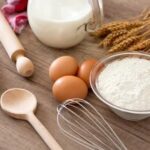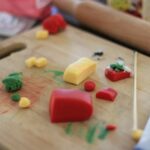What icing is best for cake decorating? Finding the right icing can make all the difference in creating beautiful and delectable cakes. With a variety of options available, including buttercream, royal icing, fondant, cream cheese icing, whipped cream icing, and ganache, it’s important to understand the benefits and limitations of each. In this article, we will explore the different types of cake icing and their suitability for various cake decorating techniques.
The choice of icing plays a crucial role in cake decorating, as it affects not only the appearance but also the taste and texture of the finished product. Whether you’re aiming for smooth and sleek finishes or intricate designs, selecting the appropriate icing is essential for achieving your desired results. Understanding the characteristics of each type of icing will enable you to make informed decisions when decorating your cakes.
From classic buttercream to elegant royal icing and luxurious ganache, there are numerous options to consider when choosing an icing for cake decorating. Each type has its own unique qualities and applications, making it important to weigh the pros and cons before deciding which one is best suited for your specific cake decorating needs.
Buttercream Icing
One of the primary advantages of buttercream icing is its smooth and creamy consistency, making it easy to work with when decorating cakes. It also holds up well in different climates, making it suitable for both indoor and outdoor events. On the other hand, buttercream tends to melt in high temperatures, which can be a disadvantage if the cake will be displayed in a warm environment or under hot lights.
Tips for Achieving the Perfect Buttercream Consistency
Achieving the perfect consistency for buttercream icing involves getting the right balance of ingredients. Overbeating can lead to a stiff and difficult-to-spread icing, while underbeating can result in a runny consistency. It’s important to follow recipes carefully and to add ingredients gradually to achieve the desired texture.
Different Variations of Buttercream Icing
There are various variations of buttercream icing that cater to different cake decorating techniques. For example, Swiss meringue buttercream offers a smoother texture and less sweetness compared to traditional American buttercream. Italian meringue buttercream has a light and fluffy consistency which works well for intricate piping and details on cakes. Understanding these variations can help decorators choose the best type of buttercream icing for their specific cake designs.
Royal Icing
When it comes to cake decorating, royal icing is a versatile and essential option that every baker should have in their repertoire. This type of icing is known for its ability to dry hard and hold intricate designs, making it perfect for creating detailed decorations on cakes and cookies.
Made from powdered sugar, egg whites, and sometimes lemon juice or cream of tartar, royal icing can be adjusted in consistency for different techniques such as piping, flooding, and even creating delicate lace designs.
One of the key advantages of using royal icing is its ability to create 3-dimensional decorations that can stand up on top of a cake or be used to construct intricate edible structures. Additionally, royal icing can be colored with food coloring to achieve vibrant shades for decorating purposes.
However, one of the challenges with royal icing is that it can dry out quickly, so it’s important to work efficiently when using this type of icing for cake decorating.
For those who are interested in trying their hand at using royal icing for cake decoration but aren’t sure where to begin, there are numerous tutorials available online that provide step-by-step instructions on how to make and use royal icing. From creating delicate filigree patterns to crafting edible flowers and figurines, royal icing opens up a world of creative possibilities for cake decorators.
Overall, when considering what icing is best for cake decorating, royal icing shines in its ability to lend a professional touch to homemade baked goods. Whether you’re aiming for elegant wedding cakes or whimsical birthday treats, mastering the art of working with royal icing can take your cake decorating skills to the next level.
Fondant
Homemade fondant allows decorators to have more control over the ingredients and flavor of the icing, while store-bought fondant offers convenience and consistent results. Both options have their own pros and cons, so it’s important to consider factors such as time, budget, and desired level of customization when choosing between the two.
For those who prefer the flexibility of customizing flavors and textures, homemade fondant may be the better choice, while decorators with limited time may find store-bought fondant to be a convenient option.
Working with fondant requires specific techniques to achieve a flawless finish on cakes. It’s essential to roll out the fondant evenly and smoothly in order to avoid lumps or creases on the cake surface. Additionally, using tools such as smoothers and cutters can help create clean edges and intricate designs with fondant. By mastering these techniques, decorators can achieve professional-looking results that are sure to impress.
Fondant is particularly well-suited for creating sculpted cakes, intricate detailing, and themed designs due to its malleable nature. Its ability to hold shapes and textures makes it an excellent choice for cake artists looking to bring imaginative creations to life. Whether you’re decorating a wedding cake with delicate lace patterns or crafting whimsical figurines for a birthday cake, fondant provides a blank canvas for turning creative visions into stunning edible works of art.
Overall, when considering what icing is best for cake decorating, fondant offers versatility in design possibilities and a flawless finish that appeals to both novice bakers and experienced professionals. With proper technique and practice, decorators can utilize this icing to transform simple cakes into extraordinary masterpieces that are as delightful visually as they are deliciously.
Cream Cheese Icing
Cream cheese icing is best known for complementing red velvet cakes, carrot cakes, and other similarly flavored desserts. The creamy texture of this icing makes it ideal for creating smooth finishes on cakes, as well as for piping intricate designs and borders. Its slightly tangy flavor pairs well with a variety of cake flavors, adding depth and richness to the overall taste.
Tips for Preventing Cream Cheese Icing From Becoming Too Soft or Runny
One potential challenge when using cream cheese icing for cake decorating is its tendency to become too soft or runny, especially in warmer temperatures. To counteract this issue, it’s important to ensure that the cream cheese and butter are at the correct temperature before beginning the mixing process.
Additionally, gradually adding confectioners’ sugar helps to thicken the icing while maintaining its creamy consistency. Refrigerating the finished cake after decorating can also help to set the cream cheese icing and prevent it from becoming too soft.
Experimenting With Flavors and Designs
While cream cheese icing is often associated with specific cake flavors, such as red velvet and carrot, it can also be adapted to enhance other types of desserts. By incorporating different extracts or flavorings, such as lemon or almond, bakers can create unique variations of cream cheese icing to pair with various cake flavors. Furthermore, experimenting with different piping tips and techniques allows for endless possibilities when it comes to decorating cakes with cream cheese icing.
Incorporating these tips and ideas into your cake decorating endeavors will help you make the most of cream cheese icing while creating visually stunning and deliciously flavorful desserts. Whether you’re a seasoned baker or just starting out in the world of cake decorating, mastering the art of working with cream cheese icing opens up a world of creativity and delicious possibilities.
Whipped Cream Icing
Stabilizing whipped cream for cake decorating is essential to ensure that it holds its shape and structure. Incorporating stabilizers such as gelatin or cornstarch can prevent the whipped cream from becoming too runny or collapsing, allowing decorators to create intricate designs without the worry of the icing losing its form.
When using whipped cream icing for cake decorating, it is important to consider the potential challenges, such as its susceptibility to melting in warm temperatures. It is best suited for indoor events or cooler environments where the icing can maintain its stability throughout the celebration.
Additionally, whipped cream may not be ideal for elaborate cake designs that require intricate detailing, as it may not hold up as well as firmer icings like fondant or royal icing. Overall, understanding what icing is best for cake decorating depends on the specific needs of each individual project and finding the perfect balance between flavor, texture, and practicality.
Ganache
One of the main advantages of using ganache for cake decorating is its ability to create a flawless, glossy finish. Whether you’re aiming for a simple but chic look or an intricate design, ganache provides a sleek canvas for your creativity. Additionally, ganache is incredibly versatile and can be adjusted to create different consistencies, making it suitable for both filling and coating cakes.
To achieve the perfect ganache consistency for your cake decorating needs, it is essential to pay attention to the ratio of cream to chocolate. A higher proportion of chocolate will result in a firmer ganache, ideal for sculpting or creating sharp edges on cakes. On the other hand, a lower proportion of chocolate will yield a softer ganache that can be used as a filling or a silky smooth coating.
When working with ganache for cake decorating, it’s important to work quickly and efficiently as it sets relatively fast. Additionally, ensuring that the temperature of the ganache is just right is crucial for achieving the desired finish on your cake. With its versatility and decadent flavor profile, ganache proves to be an excellent choice when considering what icing is best for cake decorating.
Conclusion
In conclusion, the world of cake decorating offers a wide range of options when it comes to choosing the best icing. Each type of icing – whether it’s buttercream, royal icing, fondant, cream cheese, whipped cream, or ganache – comes with its own set of advantages and potential challenges. It’s important for aspiring cake decorators to consider the specific needs of their designs and the desired flavor profile when selecting the right icing for their creations.
After weighing the pros and cons of each type of icing, it is clear that there is no one-size-fits-all answer to the question of what icing is best for cake decorating. Buttercream offers versatility and smooth texture, royal icing provides intricate detail work, fondant allows for flawless finishes and sculptural elements, cream cheese lends a unique taste experience, whipped cream brings lightness and fluffiness, while ganache adds richness and depth.
When matching an icing with a cake design, it’s crucial to take into account factors such as humidity levels, temperature sensitivity, decorative requirements, and flavor compatibility.
Whether you’re a novice cake decorator or an experienced pastry chef, my recommendation would be to experiment with different types of icings in order to find your personal favorite. Not only will this help you develop your skills as a decorator but it will also allow you to discover which type of icing best suits your individual tastes and artistic vision. So go ahead – have fun trying out various icings in your cake decorating endeavors.

Welcome to my blog about home and family. This blog is a place where I will share my thoughts, ideas, and experiences related to these important topics. I am a stay-at-home mom with two young children. I hope you enjoy reading it! and may find some helpful tips and ideas that will make your home and family life even better!





